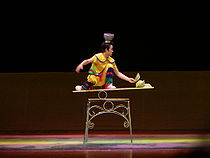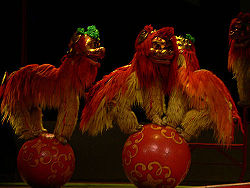
Chinese variety art
Encyclopedia

China
Chinese civilization may refer to:* China for more general discussion of the country.* Chinese culture* Greater China, the transnational community of ethnic Chinese.* History of China* Sinosphere, the area historically affected by Chinese culture...
and is still performed today.
Circus vs Variety Art
While the EnglishEnglish language
English is a West Germanic language that arose in the Anglo-Saxon kingdoms of England and spread into what was to become south-east Scotland under the influence of the Anglian medieval kingdom of Northumbria...
term "Chinese Circus" has been used to describe Chinese variety arts even in the earliest western historical text, the East views the Chinese term "circus" (馬戲) as a separate western style show altogether. Many exhibitions are similar between the two, and many are different. Elements such as clowns and other large animals are known as western style. Eastern elements include Shaolin
Shaolin kung fu
Shaolin Kung Fu refers to a collection of Chinese martial arts that claim affiliation with the Shaolin Monastery.Of the multitude styles of kung fu and wushu, only some are actually related to Shaolin...
monks, Peking opera characters and Monkey King
Sun Wukong
Sun Wukong , also known as the Monkey King is a main character in the classical Chinese epic novel Journey to the West . In the novel, he is a monkey born from a stone who acquires supernatural powers through Taoist practices...
for example.
History
The beginnings of Chinese Performance Arts have been lost to history. It is known that it existed as early as the Qin DynastyQin Dynasty
The Qin Dynasty was the first imperial dynasty of China, lasting from 221 to 207 BC. The Qin state derived its name from its heartland of Qin, in modern-day Shaanxi. The strength of the Qin state was greatly increased by the legalist reforms of Shang Yang in the 4th century BC, during the Warring...
(221-207BC). During the Qin Dynasty, Jiaodi Drama was popular with the common people and it consisted of a variety of acts such as; wrestling, musical performances, dance, martial arts, horsemanship, and juggling. In the Eastern Han Dynasty scholar Zhang Heng
Zhang Heng
Zhang Heng was a Chinese astronomer, mathematician, inventor, geographer, cartographer, artist, poet, statesman, and literary scholar from Nanyang, Henan. He lived during the Eastern Han Dynasty of China. He was educated in the capital cities of Luoyang and Chang'an, and began his career as a...
was one of the first to describe the acrobatic theme shows in the royal palaces in his writing "Ode to the Western Capital" (西京賦). The event featured shows such as "Old Man Huang of the Eastern Sea" (東海黃公), the "Dancing Fishing Dragon" (魚龍蔓衍) and "Assembly of Immortals" (總會仙倡). A grand acrobatic show was held by Emperor Wu of Han
Emperor Wu of Han
Emperor Wu of Han , , personal name Liu Che , was the seventh emperor of the Han Dynasty of China, ruling from 141 BC to 87 BC. Emperor Wu is best remembered for the vast territorial expansion that occurred under his reign, as well as the strong and centralized Confucian state he organized...
in 108 BC for foreign guests. The performance art routines became more elaborate and during the Tang Dynasty
Tang Dynasty
The Tang Dynasty was an imperial dynasty of China preceded by the Sui Dynasty and followed by the Five Dynasties and Ten Kingdoms Period. It was founded by the Li family, who seized power during the decline and collapse of the Sui Empire...
(618-907AD), the performance arts became popular in the Emperor’s court and soon spread to the gentry. Due to its new status, and raise in income, the acts became more refined. Eventually, the performance arts lost favor in the Imperial court and it then moved back to the common people and most performers performed in the street. Towards the end of the Ming Dynasty
Ming Dynasty
The Ming Dynasty, also Empire of the Great Ming, was the ruling dynasty of China from 1368 to 1644, following the collapse of the Mongol-led Yuan Dynasty. The Ming, "one of the greatest eras of orderly government and social stability in human history", was the last dynasty in China ruled by ethnic...
(1368-1644), the performers came off the street and started performing on stage. During the end of the Qing Dynasty
Qing Dynasty
The Qing Dynasty was the last dynasty of China, ruling from 1644 to 1912 with a brief, abortive restoration in 1917. It was preceded by the Ming Dynasty and followed by the Republic of China....
(1644-1911), it regained popularity with the Imperial Court and has remained a popular art form to this day.
Since the founding of the People's Republic of China
People's Republic of China
China , officially the People's Republic of China , is the most populous country in the world, with over 1.3 billion citizens. Located in East Asia, the country covers approximately 9.6 million square kilometres...
in 1949, the art forms have gained new respectability. Troupes have been established in the province
Province (China)
A province, in the context of Chinese government, is a translation of sheng formally provincial level divisions, which is an administrative division. Provinces, municipalities, autonomous regions, and the special administrative regions, make up the four types of province of administrative division...
s, autonomous region
Autonomous areas of China
In a similar fashion to the former Soviet Union's titular nations, a number of areas associated with one or more ethnic minorities are designated as autonomous within the People's Republic of China . These areas are recognized in the PRC's constitution and are nominally given a number of rights not...
s, and special municipals with theaters specifically dedicated to the variety arts. Some troupes have become world famous, playing to packed houses at home and on foreign tours.
It wasn't until the 1990s, however, when the art form was packaged as a complete theme show. Specifically the 1994 show "Golden Wind of the Southwest" (金色西南風) led the way with major successes in re-promoting the art as a whole.
Performances

- Lion dancingLion danceLion dance is a form of traditional dance in Chinese culture, in which performers mimic a lion's movements in a lion costume. The lion dance is often mistakenly referred to as dragon dance. An easy way to tell the difference is that a lion is operated by two people, while a dragon needs many people...
on top of rolling globes or balls. - Tightrope walkingTightrope walkingTightrope walking is the art of walking along a thin wire or rope, usually at a great height. One or more artists performs in front of an audience or as a publicity stunt...
- ContortionContortionthumb|upright|Contortionist performingContortion is an unusual form of physical display which involves the dramatic bending and flexing of the human body. Contortion is often part of acrobatics and circus acts...
acrobaticsAcrobaticsAcrobatics is the performance of extraordinary feats of balance, agility and motor coordination. It can be found in many of the performing arts, as well as many sports... - Balancing act while playing Chinese yo-yoChinese yo-yoThe Chinese yo-yo is a toy from China consisting of two equally-sized discs connected with a long axle. The Chinese yo-yo is kept spinning on a string tied to two sticks at its ends. Each stick is held in one hand. In modern times, it is used as a children's toy and as a performance tool in...
- Shaolin monks resisting projectiles
- Extreme kung fu demonstrations
- unicycleUnicycleA unicycle is a human-powered, single-track vehicle with one wheel. Unicycles resemble bicycles, but are less complex.-History:One theory of the advent of the unicycle stems from the popularity of the penny-farthing during the late 19th century...
with bowls balancing - Multi Plate balancing
- Tricks involving smaller animals
- Fire breathing
See also
- Chinese State CircusChinese State CircusTo say the Chinese State Circus is merely a show is grossly to underestimate it; it is the embodiment of a traditional art form which can trace its history back over 2000 years. The presentation lives and breathes with the enthusiasm of its acrobatic artistes whose whole lives centre in the...
- Chinese artChinese artChinese art is visual art that, whether ancient or modern, originated in or is practiced in China or by Chinese artists or performers. Early so-called "stone age art" dates back to 10,000 BC, mostly consisting of simple pottery and sculptures. This early period was followed by a series of art...
- Culture of ChinaCulture of ChinaChinese culture is one of the world's oldest and most complex. The area in which the culture is dominant covers a large geographical region in eastern Asia with customs and traditions varying greatly between towns, cities and provinces...
- Balancing ActsBalancing ActsBalancing Acts is a 2005 documentary by Donna Schatz that chronicles the lives of Chinese acrobat Man-Fong Tong and his wife Magda Schweitzer, a Jewish acrobat from Budapest, Hungary. The two met in Europe on the eve of World War II...
- a documentary about acrobat Man Fan Tong

